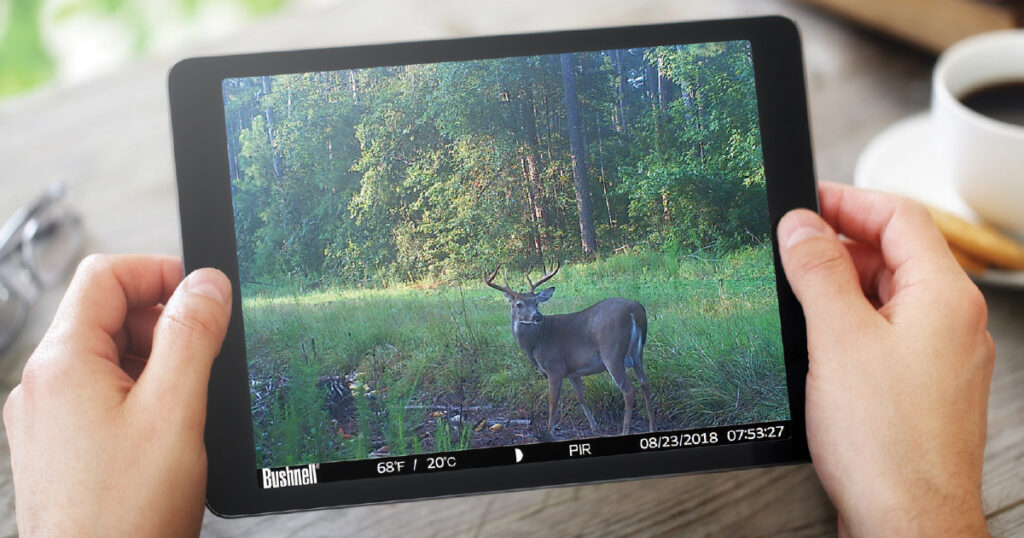Hunters looking for an extra edge this season can up their scouting game with a trail cam service that delivers real-time photos and videos to any device. Rather than hiking through the woods to retrieve a trail cam memory card, a hunter can let technology do all the work. A trail cam with cellular service streams photos and videos to any designated phone, tablet or computer. Not only does this let anyone scout from anywhere at any time, but it also reduces trips to the woods that can spook wildlife and alter their movement patterns. For those who have not considered how game cams with cell service can improve scouting, it is time to take a good look at FTC’s Game Cam Scout Service.
How a Trail Cam With Cellular Service Works
A game cam wireless service first needs to be paired with the right trail cam to work. Modern cameras are equipped with Global System for Mobile (GSM) communication or fourth-generation (4G) wireless capabilities. This technology allows cameras to use subscriber identity module (SIM) cards from mobile providers to deliver snapshots and send alerts via phone networks, like FTC wireless service.
Does a Trail Camera Require Cell Service?
Yes, trail cameras that allow remote viewing use mobile networks to deliver the images and videos to hunters’ devices, so cellular service is required. Conventional cameras do not need cell service, but these do not provide real-time notifications, and the memory cards must be physically retrieved to view the images or video.
How Much Is a Trail Cam Service?
FTC wireless Game Cam Scout Service starts at only $10 per month and can be added to an existing mobile plan to make billing seamless.
Can Trail Cam Services Be Turned On and Off?
Yes: Because the FTC Game Cam Scout Service does not require a contract, it can be canceled or added to an existing mobile plan anytime. This is ideal for hunters who do not monitor year-round.
How Often Can a Trail Camera Be Checked?
With a Game Cam Scout Service and a reliable wireless camera, a hunter can look at the trail footage remotely anytime without spooking the wildlife in the area, which is not an option with a traditional game camera using memory card storage.
Tips for Using a Trail Cam for Scouting
Successfully surveying deer or other wildlife using a trail camera can transform an average hunting season into a phenomenal one. Instead of relying on trial and error, hunters gain instant access to deer patterns, feeding spots and other habits from preseason scouting. For the best results, a scouter needs to be smart when placing the trail cam and invest in the right equipment, including a good game cam cell service.
Follow these tips to improve scouting tactics for a successful experience:
Invest in the Best Trail Cam With Cellular Service
The top trail cams with cellular service offer quick trigger speeds, reliable batteries and instant photo or video delivery. Some lower-quality game cameras can take up to 1.5 seconds to start filming after motion is detected, often leaving users with images devoid of deer. Investing a bit more for a quality game camera and a reliable cellular service affords a faster trigger speed, down to tenths of a second, plus a quality download.
An advanced camera with top-of-the-line motion sensors, night-vision capabilities and a wide field of view provides the insights hunters need to strategically place their stands. When game cameras vividly capture wildlife day or night and send real-time images and video, pre-season surveying is easier than ever. Combining quality cameras with dependable wireless uploads gives trail cam users data to learn:
- Buck-to-doe ratios
- Deer densities and inventories
- Wildlife ages and structure of a deer population
- Deer movement patterns and habits
Take Advantage of Remote Viewing
Hunters who want to remain undetected should deploy the best trail cam with cellular service they can, especially for frequent check-ins. Remote connections not only let scouters view the camera files anytime, but since humans rarely need to physically access the cameras, the areas are also disturbed less and wildlife patterns are more natural. Wireless cameras are also capable of notifying multiple email addresses or phone numbers at once, so an entire hunting party can be alerted on multiple devices. These cameras can also include two-way operation so settings can be adjusted remotely and instantly without anyone entering the woods.
Select the Trail Cam Location Wisely
Thoughtfully selecting the trail camera location is key. The best spots to place game cameras are on deer trails (especially where multiple paths converge) in view of fence gaps, near food sources, in the vicinity of bedding areas, near scrapes and alongside water sources.
Place the Camera Carefully To Avoid False Triggers
A hunter should look for a place to mount the game camera so it faces north or south because temperature changes from the rising or setting sun can trigger the motion detector. Users should also try to identify branches and other in-frame vegetation that might move when the wind blows, triggering the cameras to record images without animals in them. When hunters upgrade to a trail cam with FTC’s Scout Cam Service, they can review photos instantly to discover issues in the surroundings and eliminate the leaves or tree branches before they cause future false triggers.
Give your scouting techniques a technical advantage with a reliable trail cam running on our Game Cam Scout Service. If your wireless phone or tablet is not up to par, upgrade through FTC Wireless so outdated technology does not slow down your real-time results. To learn more about trail cam plans or how to use cloud storage for deer stand footage, visit ftc.net/services/wireless/rates-packages/game-cam-scout-service/




